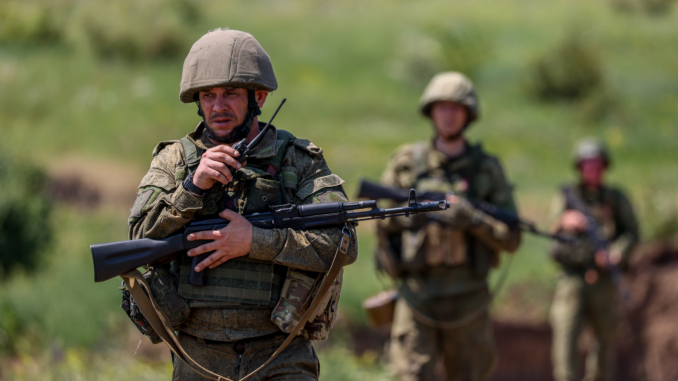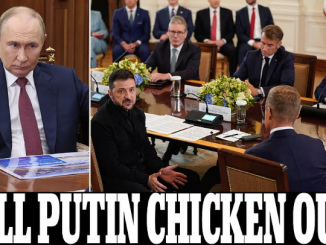
Russian Army 6th Separate Lisichansk Cossack Guards Mechanized Infantry Brigade.
| Published June 13, 2025
Russian forces seeking to create ‘buffer zone’ in Sumy after beating back Ukrainian incursion into Kursk
Recent developments in the ongoing Russia-Ukraine war have focused sharply on Ukraine’s northeastern Sumy region, where intense combat operations have resulted in shifting frontlines and contrasting claims from both Moscow and Kyiv.
Russian Forces Claim Gains in Sumy
According to multiple Russian and international reports, the Russian Ministry of Defense has announced the capture of an additional village in Ukraine’s Sumy region, as part of a broader offensive. The captured territory brings Russia’s total gains in the region to over 190 square kilometers, with their units now reportedly 20 kilometers from the city of Sumy, the regional capital.
The operation is said to be part of what Moscow refers to as its ongoing goal to “secure a buffer zone” on its western border. President Vladimir Putin has previously emphasized the strategic importance of this buffer to ensure what the Kremlin describes as “security against cross-border Ukrainian attacks.”
Russian state media and defense officials have released videos and satellite imagery purportedly showing Russian troops establishing positions and controlling roads in newly claimed areas. These have not been independently verified by international observers.
Ukrainian Military Response and Field Conditions
In contrast to Russian claims, Ukrainian President Volodymyr Zelenskyy stated that Ukrainian armed forces continue to actively contest control of key territories in the Sumy region. In a video address, he emphasized that “Ukrainian defenders are holding their ground,” and that reinforcements and drones have been deployed to disrupt Russian advances.
Ukrainian sources confirmed intense fighting in and around several rural settlements and small towns, leading to the evacuation of over 200 communities due to heavy shelling and drone strikes. The Ukrainian military has also acknowledged that the situation remains “difficult but controlled,” according to presidential adviser Mykhailo Podolyak.
The region’s proximity to the Russian border makes it particularly vulnerable to short-range artillery, drones, and sabotage operations. Ukrainian forces are using both NATO-supplied equipment and domestically produced UAVs to monitor and repel Russian movements.
International Commentary and Support
German Defense Minister Boris Pistorius recently visited Kyiv and announced €1.9 billion in additional aid to Ukraine. However, he ruled out the delivery of Taurus long-range cruise missiles, citing concerns about escalation. Instead, Germany will support Ukraine’s development of its own strike capabilities.
Elsewhere, Hungarian Prime Minister Viktor Orbán commented that the war in Ukraine is now a “security risk for Europe,” citing instability and potential refugee surges as core concerns for the EU.
Wartime Statistics and Conditions
Western intelligence estimates indicate that Russian military casualties have now surpassed one million since the war began in 2022. The Sumy offensive, described as more intense than previous border raids, is being carried out with reinforced troop presence and mechanized units.
Civilians in affected areas continue to seek shelter or relocate, while humanitarian organizations attempt to deliver aid under challenging conditions. Drone warfare, including kamikaze drones and surveillance UAVs, plays a central role in both offense and defense.
Implications of the Ongoing Battle in Ukraine’s Sumy Region
The intensification of fighting in Ukraine’s Sumy region—marked by Russia’s claim of capturing additional territory and Ukraine’s continued resistance—carries several serious implications for regional stability, international relations, and the broader trajectory of the war:
🧭 1. Strategic Expansion Beyond Donbas and Kharkiv
-
Russia’s push into Sumy suggests a widening of its military objectives beyond the eastern Donbas and southern fronts.
-
Establishing a “buffer zone” near Sumy could be used to justify future territorial claims or permanent military installations near the Russian border.
⚠️ 2. Escalation of Border Insecurity
-
Sumy’s proximity to the Russian border makes it highly vulnerable. The offensive raises the threat level along northeastern Ukraine, potentially forcing Kyiv to stretch its already thin defensive lines.
-
Russian shelling and drone activity in border towns may further destabilize areas previously less active in the conflict.
🚨 3. Civilian Displacement and Humanitarian Strain
-
Over 200 settlements are already being evacuated. This adds to Ukraine’s internally displaced population, increasing pressure on humanitarian infrastructure and aid agencies.
-
Urban centers like Sumy city could face mass displacement if fighting nears or breaches its outskirts.
🤝 4. Shift in Western Support Dynamics
-
Germany’s decision to send €1.9 billion in aid—but not Taurus long-range missiles—illustrates a cautious approach from NATO allies.
-
This cautiousness may affect Ukraine’s ability to strike deep behind Russian lines and could shift Kyiv’s expectations toward self-reliance and domestic defense production.
🛑 5. Erosion of European Unity
-
Hungarian PM Viktor Orbán’s warning that Ukraine is becoming a “security risk for Europe” reflects growing divergence within the EU over continued military support and refugee impacts.
-
These differing views may slow or limit future collective EU actions on Ukraine.
📊 6. Heavy Casualty Milestone Highlights War’s Scale
-
With Western estimates putting Russian military casualties over one million, this becomes one of the most destructive military engagements in modern European history.
-
The high cost in lives may influence future Russian troop morale and domestic sentiment, or, conversely, reinforce the Kremlin’s commitment to achieving tangible gains.
🎯 7. Increased Use of Drones and Artillery
-
The Sumy front shows how drone warfare and short-range artillery dominate the modern battlefield, especially in border areas.
-
This could shape how both sides evolve their tactics—relying more on tech, surveillance, and rapid-response forces instead of large armored pushes.
🌍 8. Risks of Spillover and Wider Regional Tension
-
A continued Russian offensive near Ukraine’s northern borders may provoke greater concern from NATO members, especially if missile systems or drones stray into allied airspace.
-
Any perceived or actual threat to neighboring NATO countries could trigger deeper involvement or a reassessment of the alliance’s posture in Eastern Europe.
Overall Takeaway:
The battle for Ukraine’s Sumy region signals a dangerous new phase in the Russia-Ukraine war—one where the frontlines are expanding and the stakes are rising. Russia’s territorial push near Sumy, framed as a strategy to create a “buffer zone,” underscores its long-term intentions to reshape borders and maintain pressure on Kyiv. Meanwhile, Ukraine continues to resist, but faces intensifying military and humanitarian strain.
This escalation is not just a battlefield development—it reverberates across Europe, where unity over support for Ukraine is showing signs of stress. The high cost in lives, displacement of civilians, and growing tension along the border areas paint a picture of a conflict that is far from contained. As both sides entrench and international responses evolve, the war enters a more volatile and unpredictable chapter.
SOURCES: THE TIMES OF INDIA – Moscow claims capturing another village in Sumy, Putin seeks ‘buffer zone’
THE MOSCOW TIMES – Russian Army Says It Captured Another Village in Ukraine’s Sumy Region
THE INDEPENDENT – Zelensky claims his troops ‘gradually pushing back’ Putin’s forces in Sumy
DAILYMAIL ONLINE – Zelenskiy says Ukrainian troops pushing back Russian forces in Sumy





Be the first to comment